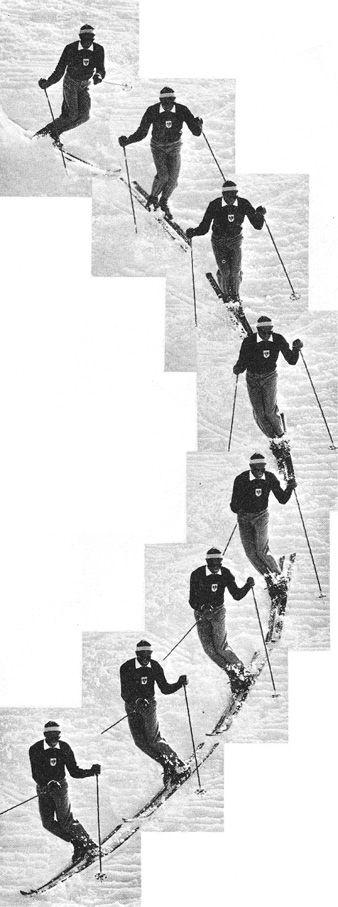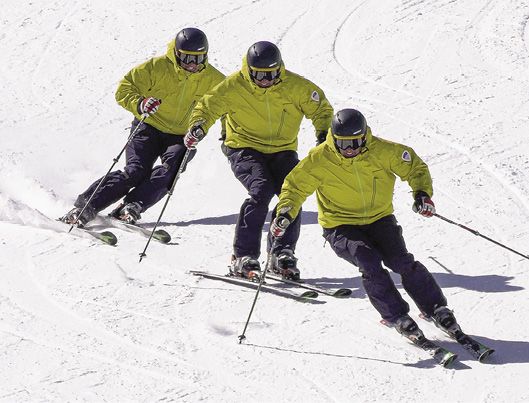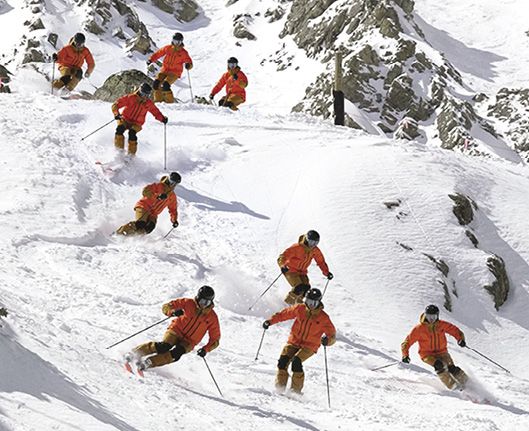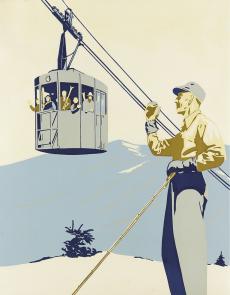SKIING HISTORY
Editor Seth Masia
Managing Editor Greg Ditrinco
Consulting Editor Cindy Hirschfeld
Art Director Edna Baker
Editorial Board
Seth Masia, Chairman
John Allen, Andy Bigford, John Caldwell, Jeremy Davis, Kirby Gilbert, Paul Hooge, Jeff Leich, Ron LeMaster, Bob Soden, Ingrid Wicken
Founding Editors
Morten Lund, Glenn Parkinson
To preserve skiing history and to increase awareness of the sport’s heritage
ISHA Founder
Mason Beekley, 1927–2001
ISHA Board of Directors
Rick Moulton, Chairman
Seth Masia, President
Wini Jones, Vice President
Jeff Blumenfeld, Vice President
John McMurtry, Vice President
Bob Soden (Canada), Treasurer
Einar Sunde, Secretary
Richard Allen, Skip Beitzel, Michael Calderone, Dick Cutler, Ken Hugessen (Canada), David Ingemie, Joe Jay Jalbert, Henri Rivers, Charles Sanders, Christof Thöny (Austria), Ivan Wagner (Switzerland)
Presidential Circle
Christin Cooper, Billy Kidd, Jean-Claude Killy, Bode Miller, Doug Pfeiffer, Penny Pitou, Nancy Greene Raine
Executive Director
Janet White
janet@skiinghistory.org
Membership Services
Laurie Glover
(802) 375-1105
laurie@skiinghistory.org
Corporate Sponsorships
Peter Kirkpatrick
(541) 944-3095
peterk10950@gmail.com
Bimonthly journal and official publication of the International Skiing History Association (ISHA)
Partners: U.S. Ski and Snowboard Hall of Fame | Canadian Ski Museum and Hall of Fame
Alf Engen Ski Museum | North American Snowsports Journalists Association | Swiss Academic Ski Club
Skiing History (USPS No. 16-201, ISSN: 23293659) is published bimonthly by the International Skiing History Association, P.O. Box 1064, Manchester Center, VT 05255.
Periodicals postage paid at Manchester Center, VT and at additional mailing offices. Postmaster: Send address changes to ISHA, P.O. Box 1064, Manchester Center, VT 05255
ISHA is a 501(c)(3) public charity. EIN: 06-1347398
Written permission from the editor is required to reproduce, in any manner, the contents of Skiing History, either in full or in part.
Whatever Happened to Up-Unweighting
The keystone of skiing for decades, it’s largely been replaced by terrain-unweighting.
Photos above: Fred Iselin demonstrates “lift and swing” in a stem christiania. From Invitation to Skiing, F. Iselin and A. C. Spectorsky, 1947.
Exhortations of “down-UP!” used to ring from the lips of instructors and aspirational skiers as they initiated their parallel turns with up-unweighting. Countless one-page instructional tips in ski magazines reminded readers of its importance. Today, this former foundation of sound skiing is considered déclassé by many technically minded skiers. What happened?

eschewed rotation, but still espoused up-
unweighting. It was all in the knees and
ankles. From The New Official Austrian
Ski System, 1958.
The idea of “unweighting,” freeing the skis from the snow to facilitate starting a turn, goes back to the earliest days of Alpine skiing. And the obvious method of doing it was to toss the body upward. This was expressed well by Charles Proctor and Rockwell Stephens in their 1936 book, Skiing – Fundamentals, Equipment and Advanced Techniques. “[the] Christiania … starts with a rise or upward lift of the body, followed by a pronounced dip… The primary purpose of the rise and dip is to unweight the skis, for it is obviously easier to flick the heels out and thus start the turn when they are unweighted than when the runner’s weight is pressing them down into the snow.” In the days when slopes were ungroomed and the skis were long and stiff, “flicking the heels” demanded some significant unweighting. Brute force was needed, and the big “down-UP!” provided it. The technique was a cornerstone in ski instruction systems of all nationalities. Tyros were introduced to the first part of the movement pattern with “Bend zee knees!” The “UP!” came with the stem christiania, coupled to a strong upper-body rotation in the direction of the new turn.
Even as slopes became packed down and upper-body rotation disappeared from some teaching systems, making short, snappy turns with stiff wooden skis was more of an exercise in linked edge-sets than the linked arcs that became possible with the second generation of metal and fiberglass skis. Linking those edge-sets required significant “flicking of the heels” and pivoting of the skis, which in turn required significant and prolonged unweighting. Up-unweight was still the obvious choice.
Except in moguls. Once there were enough skiers on the slopes to create them, skiers figured out that they could employ the bumps to do the unweighting. Better skiers realized that oftentimes a bump could provide too much lift, turning each mogul crest into a ski jump. To avoid catastrophe, they learned to make the “down” but forgo the “UP!” entirely. Skiers’ bodies were still getting projected upward, but it was being done by the terrain, not the legs. Whether or not this is up-unweighting is an academic question, but the “down-UP!” was gone. (Some called this “down-unweighting,” but many technical aficionados argue that down unweighting is something quite different.)

flexes to absorb most of the unweighting
force as he links two short turns. Ron
LeMaster photo.
As skis and slope grooming steadily improved, the nature of short turns on all terrain has become more and more like skiing in moguls. The reason for this was revealed by Georges Joubert and Jean Vuarnet in their 1966 classic, How to Ski the New French Way (Comment se perfectionner à ski). At the beginning and end of a turn, the skis are traveling on a slope that is shallower than the fall line. So making a turn on a smooth slope is like skiing through a dip, and linking turns on that slope is like skiing through moguls. The sharper the turn and the steeper the slope, the bigger the “virtual bumps.”
A key aspect of improved ski design has also reduced the need for unweighting: The skis initiate turns more easily, and shape tighter arcs due to their shorter length and deeper sidecuts.
Through time, the details of the up-unweighting movement evolved. Before the Austrian school stormed the ski world with wedeln, short-swing and their innovative system of the late 1950s, skiers were taught to flex and extend at the ankles, knees, and waist. The new Austrian method encouraged skiers to do it all at the knees and ankles, thrusting the knees forward as they were bent, while remaining erect from the waist. This became the fashion, even though the best racers of the time bent much less at the ankles and more at the waist. In the mid 1960s, it became apparent that the best racers were skiing in more of a seated position: still bending their knees a lot, but bending more at the waist and less at the ankles. This presaged the advent of tall plastic boots in the 1970s that greatly limited the range of ankle flex but greatly improved the skier’s ability to work the skis. Since then, that way of moving up and down has remained with us.

uses a variety of unweighting techniques,
including up-unweighting, to achieve
different ends in each turn. Ron LeMaster
photo.
Today, snow grooming and ski design are so good that not only is less unweighting usually required than in the old days, but that which is needed is often provided by the dynamics of the turn itself. The skier simply goes along for the ride or, in more dynamic turns, flexes to absorb the excess unweighting that the turn would otherwise produce.
This is not to say that up-unweighting is gone from the repertoire of the good skier. Whether you define up-unweighting as leg-powered lift, or broaden the definition to include terrain-induced lift, it’s still with us. Even under the narrower meaning, it’s the sharpest tool in the skier’s kit for many situations. Used with a bouncing rhythm, it’s a go-to technique for introducing tyros to powder snow, and all experts often find themselves doing a big down-UP with a forceful upper body rotation in heavy, unpacked snow. In good skiing generally, unweighting by extending is often useful, effective and commonplace. Moreover, it gives your leg muscles a chance to relax, expands your chest so you can breathe deeper, gives you a better view of the slope below, and just plain feels good. 


Table of Contents

Corporate Sponsors
ISHA deeply appreciates your generous support!
WORLD CHAMPIONSHIP ($3,000 AND UP)
Gorsuch
Polartec
Sport Obermeyer
Warren and Laurie Miller
CHAMPIONSHIP ($2,000)
Fairbank Group: Bromley, Cranmore, Jiminy Peak
Hickory & Tweed Ski Shop
Rossignol
Snowsports Merchandising Corp.
WORLD CUP ($1,000)
Aspen Skiing Company
Berkshire East Mountain Resort/Catamount Mountain Resort
Bogner
Boyne Resorts
Dale of Norway
Darn Tough Vermont
Dynastar | Lange | Look
Gordini USA Inc. | Kombi LTD
HEAD Wintersports
Intuition Sports, Inc.
Mammoth Mountain
Marker-Volkl USA
National Ski Areas Association
Outdoor Retailer
Ski Area Management
Ski Country Sports
Sports Specialists, Ltd.
Sun Valley Resort
Vintage Ski World
World Cup Supply
GOLD ($700)
Larson's Ski & Sport
Race Place | BEAST Tuning Tools
The Ski Company (Rochester, NY)
Thule
SILVER ($500)
Alta Ski Area
Boden Architecture PLLC
Dalbello Sports
Deer Valley
Ecosign Mountain Resort Planners
Fera International
Holiday Valley
Hotronic USA, Inc. | Wintersteiger
MasterFit Enterprises
McWhorter Driscoll, LLC
Metropolitan New York Ski Council
Mt. Bachelor
New Jersey Ski & Snowboard Council
Russell Mace Vacation Homes
Schoeller Textile USA
Scott Sports
Seirus Innovations
SeniorsSkiing.com
Ski Utah
Steamboat Ski & Resort Corporation
Sundance Mountain Resort
Swiss Academic Ski Club
Tecnica Group USA
Timberline
Trapp Family Lodge
Western Winter Sports Reps Association
World Pro Ski Tour
Yellowstone Club


